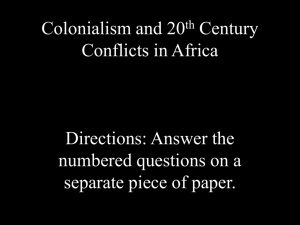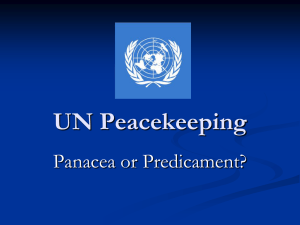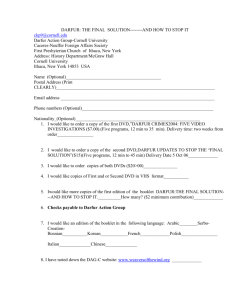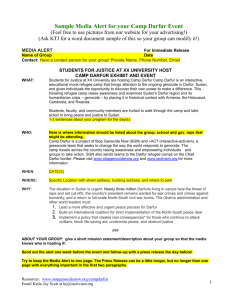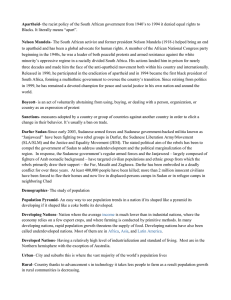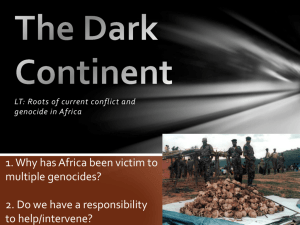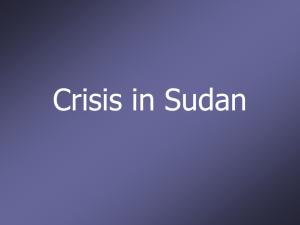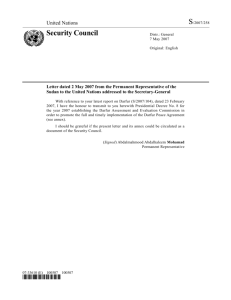Darfur, Sudan
advertisement
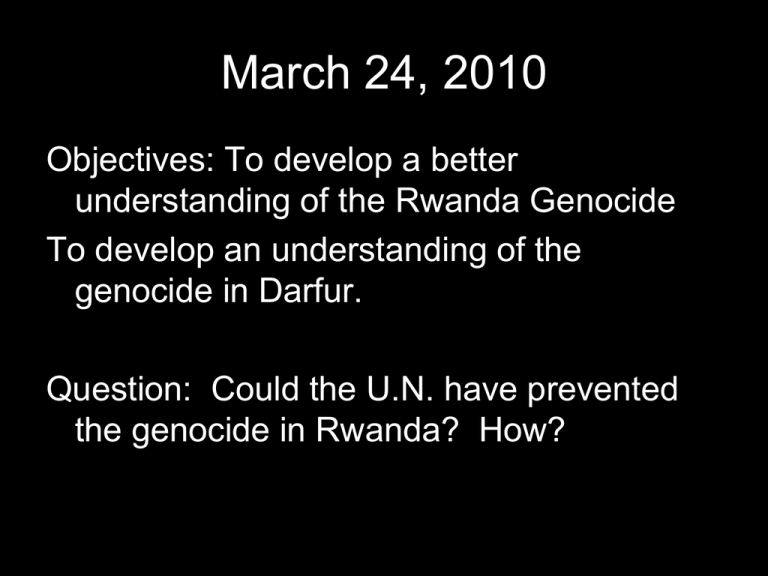
March 24, 2010 Objectives: To develop a better understanding of the Rwanda Genocide To develop an understanding of the genocide in Darfur. Question: Could the U.N. have prevented the genocide in Rwanda? How? Agenda • Discussion on Rwanda Genocide • Get with your groups- each person must be prepared to share out. • Turn in notes • Take out paper to take notes on Darfur • Final 5 Ghosts of Rwanda Post Viewing Assignment • From the perspective of the group you followed, answer the following questions: 1. What involvement and role did your group play in the Rwandan Genocide? 2. How does your group explain the events of the genocide? (main causes, events and players) 3. Were there any mistakes on your part? Explain those mistakes and what could be done to correct those mistakes. If you believe no mistakes were made, would other groups claim that you made mistakes? Why? 4. From your stand point, list and explain the Five most important events of the Genocide. Ghosts of Rwanda Class Discussion • What part of the film had the most impact on you? • Who in the film might be haunted by the “ghosts of Rwanda”? How/why? • Why was the Red cross more effective in Rwanda than the U.N.? • Should powerful western nations ,including the U.S., be blamed for the 800,000 dead? Darfur Genocide “Never Again” Again? Darfur is located in the western region o Sudan Darfur, Sudan • Sudan is the largest country by area in Africa • Darfur is a region in western Sudan, approximately the size of Texas • 6 million people used to live in Darfur History of Conflict in Sudan Sudan’s borders encompass many ethnic and religious groups – North: Arab, Muslim – South: African, Christian – Darfur: African, Muslim, Fur, Masalit and Zaghawa tribes Northern Sudan was constructed without ties to Southern Sudan, and the Darfur region wasn’t annexed as a province of Sudan until 1916, almost 50 years after the North and South were unified. History of Conflict in Sudan • 1956 Sudan gains independence from British rule • Civil war between North and South from 19551972 and again from 1983-2002 – South Sudanese not represented in government – While oil was discovered in Southern Sudan in the 1970s, the government demanded all of the oil revenues be funneled to the national government Beginning of Darfur Conflict • In 2003, two rebel groups from Darfur rise up against the Sudanese government – Sudanese Liberation Movement (pictured) – Justice and Equality Movement The political aim of the rebel groups is to compel to Sudanese government to address underdevelopment and political marginalization of the region . War-torn Sudan • 21 yr. Civil War between north and south – – – – Why? Land first, then oil as well 2 million deaths related to conflict 1/4 of these victims were children many suffer from malnutrition as result • Economically bankrupt – War cost government $2 million/day – Oil businesses have left due to violence Religious Demography • 70% Sunni Muslim • 25% Indigenous (tribal) Religions • 5% Christian • North Sudan Muslim • South Sudan Indigenous Religions and Christians • Civil War between north and south formally ended January 9, 2005 – peace agreements brokered by the United States allocated government positions and oil revenue to the rebels in the south. – NIF (National Islamic Front) in power (Arab) Sudanese President Lt. Gen. Hassan al-Bashir – Insurgent/rebel groups: Sudan Liberation Army (SLA) and Justice and Equality Movement (JEM) • Made up of African tribal farmers including Fur • Recent conflict – the beginning of the genocide – February 2003: SLA and JEM demanded that the Sudanese government begin to share power and end the economic marginalization of Darfur. – The government responded by targeting the civilian populations from which the rebels were drawn. • Led to refugee crisis – “ethnic cleansing” Darfurian refugees Mother and Children in Refugee Camp Refugee Camp Who are the “Janjaweed”? • The Janjaweed are perhaps 20,000 Arab militiamen who are responsible for the mass killings. • Janjaweed is Arabic for “Devil on a horse” •The Government of Sudan is undeniably linked to the Janjaweed. •The Janjaweed systematically rape women and girls, castrate, brand and beat men and boys, and torture all = GENOCIDE Human Rights Watch (2004) • HRW obtained confidential Sudanese government documents. • “It’s absurd to distinguish between the Sudanese government forces and the militias – they are one. These documents show that the militia activity has not just been condoned, it’s been specifically supported by Sudan government officials.” – Exec. Dir. Africa Div. HRW Peter Takirambudde March 25, 2010 • Objectives: To develop an understanding of the situation in Darfur, and Uganda. • Question: Describe what led to the situation in Darfur. • Agenda: Lecture The World Takes Notice of Genocide in Darfur • June 24th, 2004, for the first time in its history, the Committee on Conscience of the United States Holocaust Memorial Museum declared a “genocide emergency” in the Sudan • On July 22, 2004 the U.S. Congress passed resolutions declaring Genocide in Darfur, Sudan. • On January 25, 2005, the United Nations Commission of Inquiry declared “government forces and militias conducted indiscriminate attacks, including killing of civilians, torture, enforced disappearances, destruction of villages, rape and other forms of sexual violence, pillaging and forced displacement, throughout Darfur. These acts were conducted on a widespread and systematic basis ... The vast majority of the victims of all of these violations have been from the Fur, Zaghawa, Massalit, Jebel, Aranga and other so-called 'African' tribes”. History (Cont.) The war, which risks inflicting irreparable damage on a delicate ethnic balance of seven million people who are uniformly Muslim, is actually multiple intertwined conflicts. One is between governmentaligned forces and rebels; a second entails indiscriminate attacks of the government-sponsored Janjaweed militia on civilians; and a third involves a struggle among Darfur communities themselves. Its implications go far beyond Darfur's borders. The war indirectly threatens the regimes in both Sudan and Chad and has the potential to inspire insurgencies in other parts of the country. “I was sleeping when the attack on Disa started. I was taken away by the attackers. They were all in uniforms. They took dozens of other girls and made us walk for three hours. During the day we were beaten and they were telling us: "You, the black women, we will exterminate you, you have no god." At night we were raped several times. The Arabs guarded us with arms and we were not given food for three days.” Female refugee from Disa Facts • An estimated 400,000 innocent civilians deaths • More than 200,000 people have been displaced and fled to refugee camps in neighboring Chad • Almost 2 million people have been internally displaced • More than 10,000 people die each month • As many as 1 million civilians could die in Darfur from lack of food and from disease within coming months The majority of the victims are from the Fur, Zaghawa, Massalit, Jebel, Aranga and other African tribes. This is Zahra. After her husband and sons were murdered, the Janjaweed carried her and her sisters off and gang-raped them. The sisters were murdered, and Zahra was finally released, naked, after the Janjaweed slashed her leg to mark her forever. The Janjaweed raid villages, burn the homes, destroy the crops and poison the wells. Survivors from the attacks are unable to return home because their villages are uninhabitable. What is the U.S. Doing? • Although they can and must do more, the United States has done more than any other nation in the world. The Bush Administration provided the most funding to the Darfur relief effort. • In early-March, 2005 Senators Sam Brownback (KS) and Jon Corzine (NJ) introduced into the Senate the Darfur Accountability Act (S 495). • In mid-March, 2005 Representative Donald Payne of New Jersey introduced the Darfur Genocide Accountability Act (HR 1424). • Neither of these bills have been passed into law. • The FY05 Emergency Supplemental bill approved $90.5 million in relief to Darfur ($50 million for the African Union mission in Darfur and $40.5 million for disaster aid) What is the World Doing? • The U.N. Security Council has passed several ineffective resolutions. The resolutions are repeatedly violated by the Sudanese government. • The African Union (AU) currently has 7000 troops in Sudan. The AU remains grossly under-funded and ineffective. Many more peacekeeping troops are needed in the region. This family fled their village after their father and brother were killed, and then the mother fell ill and could no longer walk. So now the family is headed by Haiga Ibrahim, a 16-year-old girl, who is on the left. Bahria Mohammed Ahmed, right, with her mother at Abu Shouk camp. Two of her children disappeared as the family trekked toward refuge, and she arrived this week without them. "I talked to scores of refugees who several weeks ago watched as their wives were raped and as their brothers and fathers and sons were killed before their eyes. Scattered. Entire villages wiped out. It's savagery. It's slaughter, and it is going on, in essence, as we speak." U.S. Senator Bill Frist Children like Magboula are particularly at risk because they no longer are nursing and need food, but are particularly likely to die of diarrhea, malaria and other ailments. 70% of the deaths in Darfur are children under five. The main cause of death in the refugee camps is diarrhea which account for ¼ of the recorded deaths. 80% of the children under five years old are suffering from severe malnutrition These two orphans from Darfur fled to the northern part of the Chad/Sudan border after their parents, uncle and older brother were either killed or went missing in an attack by the Janjaweed militia on their village, Ab-Layha. Nijah Ahmed, 4, is carrying her little brother, Nibraz, who is 13 months old and malnourished. “At 7am in August 2003, our village was surrounded by the Janjaweed; we heard machine guns and most of the people ran away, some were killed while trying to escape. My sister, M, aged 43, was captured by the military and the Janjaweed. They tried to sleep with her. She resisted, I was present and could hear her: "I will not do something like this even if you kill me" and they immediately killed her.” I, from Miski. “They’re trying to kill all of the children in order to wipe out the next generation.” Due to drought and poisoned wells, water is becoming scarcer which will contribute to increased deaths. “When we tried to escape they shot more children. They raped women; I saw many cases of Janjaweed raping women and girls. They are happy when they rape. They sing when they rape and they tell that we are just slaves and that they can do with us how they wish.” A, a 37-year-old from Mukjar GET OUT A PIECE OF PAPER FOR A SHORT QUIZ! Darfur Genocide Quiz 1. In what year did the fighting re-erupt in the Sudan? 2. Who are the two sides in the Sudanese Civil War and what are they fighting about? 3. Why is Darfur the center of the genocide? 4. Who are the Janjaweed? 5. What are some of the Janjaweed tactics? 6. How many people have been displaced? (internally and externally) 7. What is the estimate for the number killed so far? 8. Which age group makes up 70% of the deaths in Darfur? 9. What are some things the US is doing about this genocide? The UN? 10.What do you think should be done? Final 5 • What more can the U.S. and the U.N. do for the area of Darfur? How would you convince our Government or the U.N. that something more needed to be done?
